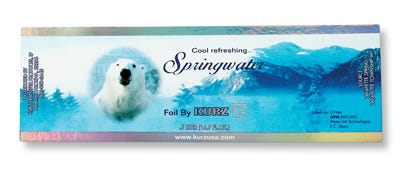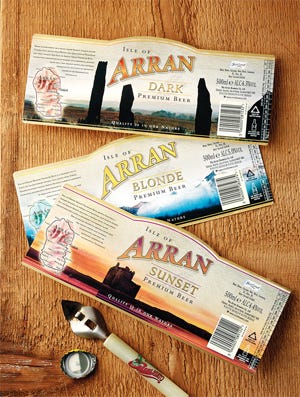Package Manufacturing: Cold foil, warm labels
January 29, 2014

What do humans and magpies have in common? We are both attracted to things that glitter and sparkle. A metallic look stands out and can convey an impression of high value. The design community has long used this effect to create packaging with shiny, bright features that increase product value as well as focus attention at the point of sale. Of course, sometimes the designer is constrained by technical or financial restrictions, because not every design concept can be realized or can be achieved within the outlined financial scope.
Cold-transfer foil has significantly broadened the scope of design potential. Using this technique, high-gloss, metallic patterns may be created that otherwise would not be possible. Fine lines, filigree cutouts—even on a large transfer area—minute details and even halftone pictures are a viable option. Also, the foil can be used without restriction on large or full surfaces.

Cold-foil transfer can be used to create virtually any color for labels with eye-catching, metallic effects.
An additional wealth of design possibilities results from the ease with which cold foil may be overprinted using four-color printing. This allows for an extremely effective combination of colors and metallic brilliance, and a multitude of effects may be realized, since not only the overprinted color but also the cold foil itself may be screened. By selecting opaque or transparent colors in conjunction with different screening values of the colors, as well as the cold foil, highly variable, metallic effects and gloss levels are achievable.
To learn more about package decoration, visit PD's LABELING INFO CHANNEL online at: www.packagingdigest.com/ info/labeling
Using cold foil with holographic patterns has also proven to be a real attention grabber. Here again, overprinting offers a virtually endless range of options. Finally, the ability of cold foil to be overprinted means that it is available at any time in the most varied colors, because printing over silver foil with transparent colors provides almost any shade or color desired.
Cold-foil transfer also enables the use of "side-by-side" print and foil. Cold foil is transferred in-register to the printed colors so there is no issue concerning registration tolerances. This precise registration increases design scope; for example, it allows exact continuation of a printed motif using cold foil. The random change between foil and color drawing enables the creation of attractive effects.

Cold foil also offers benefits for applications in which metallized paper is frequently used, such as in the label market. Large surfaces may be covered with foil while leaving any desired area white. Therefore with bar codes, for example, there is no need for any elaborate, preliminary white printing. Moreover, foil recesses also permit the clear, unobstructed printing of light colors. Cold-foil use in the label industry also has certain advantages when compared to hot stamping. While the paper used in the hot-stamping process may become deformed due to the application of pressure and heat, the cold-foil transfer process does not cause a similar condition, even in large-area use.
But cold-foil transfer is not a replacement for hot stamping. In hot stamping, the foil is transferred to the surface by a combination of heat and pressure. It is this very process that provides the distinct advantage of the technique. The pressure used forms a slight depression in the substrate with a unique sense of touch. The effect of the heat used results in a special bond between the substrate and foil and also associates the hot-stamping process with a one-of-a-kind gloss level. The visual quality of hot stamping remains unequalled and consequently, cold-foil transfer does not offer a realistic competitive alternative. Especially when it comes to luxury product packaging, hot stamping is still the first choice.
Another advantage to hot stamping is its tactile quality. Nowadays, the human brain is constantly being bombarded with different stimuli. Given this, it is a real challenge to create, through packaging design, visual signals that are eye-catching and stimulate the urge to buy. Hot stamping can provide such an impetus, and beyond this, it is effective in an area where sensory perception is not yet overwhelmed: tactile impression. Structural and relief stamping are not only pleasing to the eye, but they also possess physical characteristics so that specific packaging may be compared against competitive products. While visual differentiation has been widely pursued, tactile features still offer the potential for product positioning. The hot-stamping technique lends itself perfectly to this opportunity.
Hot stamping and cold-foil transfer each offer specific benefits, thus it is the application that should determine which decoration method should be used. Cold-foil transfer may be conducted in-line at print-production speed, without the need for stamping tools. It consequently has cost- and timesaving benefits when compared to hot stamping. In particular, patterns are significantly cheaper and faster to produce when stamping dies are not required and die adjustment and cutting are unnecessary. Also, on small-run jobs or where design changes are needed, this method is especially economical.
Generally, cold-foil transfer is particularly suited to those applications where metallic-gloss decoration tends to be avoided for either technical or cost reasons. Due to the high brilliance achievable using cold-foil finishing, it is an attractive alternative to metallized paper or laminate use. The cold-foil process is also a potential replacement for metallic colors, especially those generated by flexo or offset printing, since they cannot offer comparable gloss.
Cold foil is increasingly found on a host of diverse objects, from calendars and greeting cards, to labels for sparkling wines, fruit juices and liquors, and from magazine covers to business cards. Cold-foil transfer allows for a simple yet effective upgrade of packaging, and it is predicted that the use of metallic-gloss foils will grow using this flexible process.
The author, Wolfgang Burkard, is head of product management for the graphics industry at Leonhard Kurz GmbH & Co. KG.
You May Also Like


